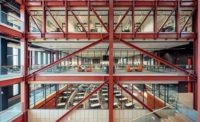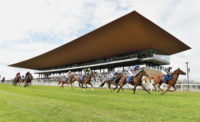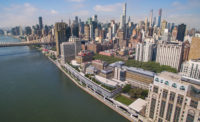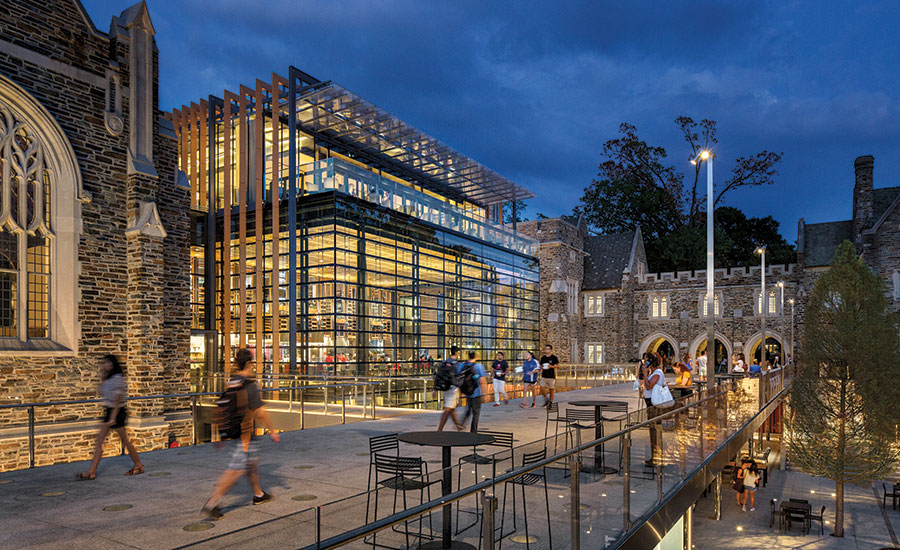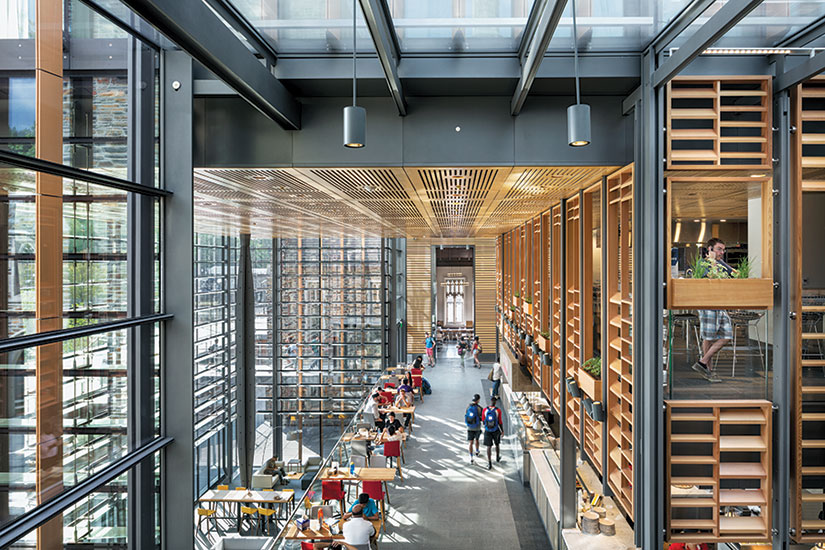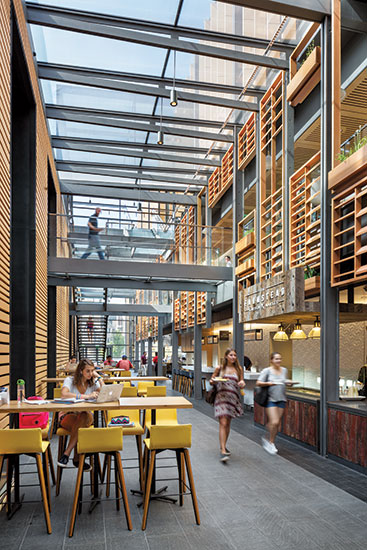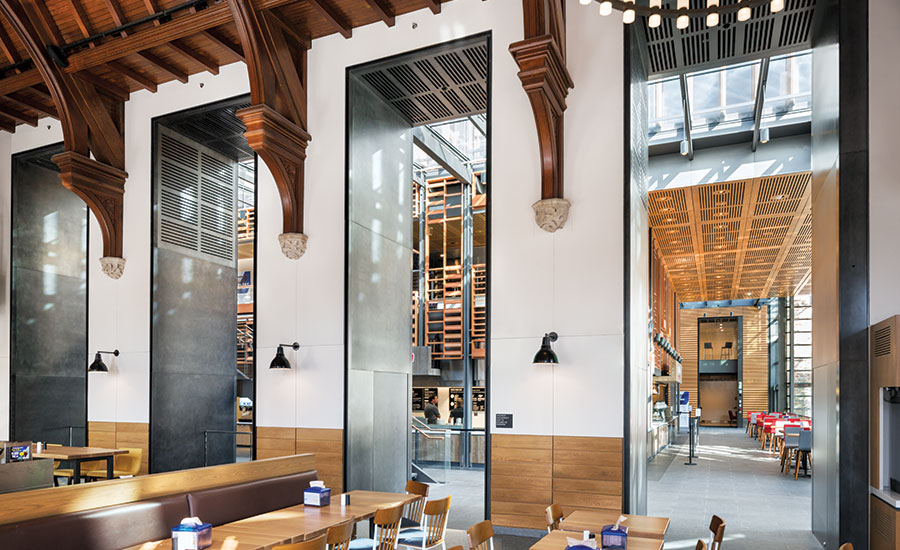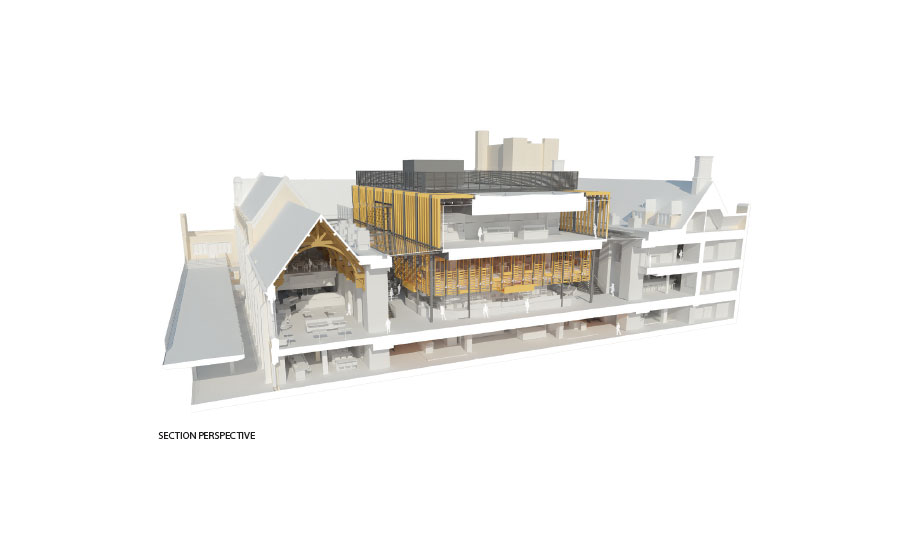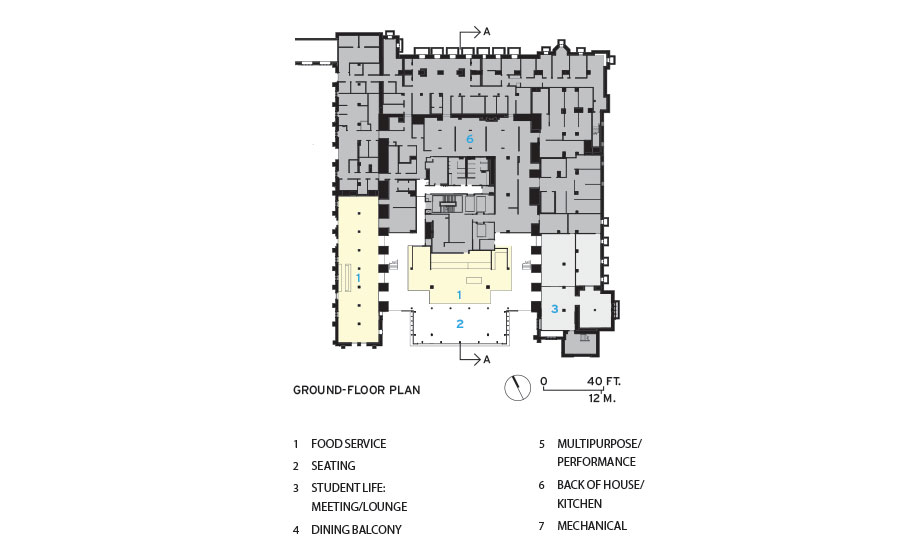Duke University’s West Campus Union by Grimshaw
Durham, North Carolina

The building can be entered at grade or via a new elevated walkway by Architecture Operations D.P.C., which collaborated with James Carpenter Design Associates. This bridge/pavilion connects through arched passages to the main historic quad to the east (just renamed for the original campus architect, Julian Abele) and to the Bryan Campus Center to the west.
Photo © James Ewing

Photo © James Ewing

The soaring atrium links to West Union’s wood-screened center, with its variety of food vendors and seating.
Photo © James Ewing

Bridges and stairs connect to the historic east wing.
Photo © James Ewing

Extra-wide walls between the insertion and the existing Great Hall house mechanicals.
Photo © James Ewing

Image courtesy Grimshaw

Food service continues in the historic Cambridge Inn refectory to the north, where the architects have inserted a dining balcony.
Photo © James Ewing

A living room and café are some of the many social spaces that are carved out of the original east wing.
Photo © James Ewing

Groud-floor plan
Image coutesy Grimshaw

Plaza-level plan
Image courtesy Grimshaw

Second-floor plan
Image courtesy Grimshaw

Image courtesy Grimshaw












Architects & Firms
Sometimes called “the Gothic Wonderland,” Duke University’s West Campus in Durham, North Carolina, is a storybook enclave. Designed by the office of Horace Trumbauer—under the direction of chief designer Julian Abele, one of the first influential African-American architects—and constructed between 1927 and 1932 (with the Olmsted Brothers overseeing the landscape), it is characterized by its bucolic quads and Collegiate Gothic architecture rendered in the local variegated Duke Stone. It is not a place that takes change lightly.
Additional Information:Jump to credits & specifications
But, as one of the country’s most competitive universities, the school also knows the importance of staying current to attract the best students and is accustomed to adapting to the times, as it has with its recent reinvention of the historic West Campus Union building. Designed by the New York office of Grimshaw architects, the renovation and expansion transforms a creaky dining facility into a dynamic community center. “For us, there is an important relationship between the academic, residential, and social environments,” says Larry Moneta, vice president for student affairs. “West Union is the nexus—where these three circles overlap.” The original building, completed in 1930 at the heart of the campus, was showing its age. The 200-foot-long Great Hall refectory and adjacent Cambridge Inn dining room may have been hallowed, but they were inflexible spaces, and much of the rest of the building was given over to grab-and-go food vendors and administrative offices. There was nowhere inviting to gather or linger. And it was impenetrable. “It was like a fortress,” says Mark Husser, Grimshaw’s partner in charge. “You couldn’t move through it.”
For the building’s next chapter, the university hoped to reconceive it as a hub for students, faculty, and staff to convene in a variety of spaces—formal and informal. Putting food front and center by displaying preparation, using locally sourced ingredients, and engaging local chefs at 13 diverse venues—with offerings from Tandoor dishes to paella to soul food—draws students and encourages them to stay. The approach reflects the farm-to-table zeitgeist but was also shaped by a widely shared cultural experience. “In my house,” says Moneta, “every important family conversation was in the kitchen. There’s a little of that in our thinking as well. Where one eats is an important place for friendships and relationships and community to thrive.”
West Union is the focal point of a larger plan to reactivate this part of campus—through landscaping, infrastructure, and architecture. The project began with an invited competition that included Foster + Partners, Bohlin Cywinski Jackson, and Shepley Bulfinch with James Carpenter—a clear indication of the university’s interest in the contemporary despite their embrace of the traditional, as well as a hint that it would probably substitute steel and glass for the ubiquitous stone. As revered as West Union had been—with its towers, clay-tile roofs, tracery, and limestone ornamentation—the love did not extend to the original volume that nestled within its core: a squat, flat-roofed rabbit warren housing a cafeteria servery. Grimshaw, which won the contract in 2012, removed this element, inserting a glass-and-steel box into the remaining U-shaped structure. Though bold in its materiality, the new West Union “bows to the historic legacy,” notes project associate David Cook, pointing to the design’s attention to existing elements through framed views and juxtapositions, such as the dining balconies the team has suspended amid the oak trusses in the Great Hall and the Cambridge Inn. And the building is respectful with its scale: from the sacrosanct Chapel quad to the north, the extension is not visible.
“We inverted the Collegiate Gothic,” says Husser. “The building is transparent and is activated by the life inside. Because it sits at the middle of major circulation routes, we created two ground levels to allow people to pass through.” Students enter at the lower level and via bridges above into a soaring atrium, buzzing with activity. Visitors flow around and through the core, which is screened in louvered Western Red Cedar and ringed by a bazaar of food stalls called “The Market” and by glass-topped passages that link to the existing building on three sides. Glass-and-steel stairs and bridges lead to the balconies to the west and north and to the more compressed student-life areas—lounges and meeting rooms—in the east wing. Ample apertures enable views up, down, and across the interior, as undergraduates share meals or hunch over laptops, faculty meet over coffee, and maintenance workers break for lunch.
True to Grimshaw form, and in response to the historic precedent, the architects have put the structure on display by exposing more of it in their renovation, and also by revealing how the pieces come together in the new construction, notably with towering steel members, which frame the exterior and support the skylight-enclosure system as well as the curtain wall. Here structural glass fins tie into castellated steel columns, providing lateral bracing. Laminated with a ceramic frit, the fins also filter light, easing the transition from this bright, acoustically live space into the opaque, more hushed historic wings. To create the threshold between these spaces, the team punched openings in the dividing walls, which they designed to be extra-wide—7 feet—to hold the extensive mechanicals required by the numerous kitchens. Accommodating the services, given the constraints of the existing construction, was the biggest challenge, say the architects, who also excavated down 10 feet and out to the south, to meet the required needs. With the complex m/e/p systems and all the added ductwork and ventilation, Husser likens the process to designing a lab building.
Just as the new West Union reflects the current attitude toward food preparation and dining, it also communicates Duke University’s perspective on education through interaction. The students clearly love the food, but the social element does not escape them, either. “It’s helping build the community we lost when we left the freshman dining hall,” says sophomore Maggie Finney. “And,” underscores her friend Hawa Tucker, “you run into everyone.”
PeopleArchitect: GRIMSHAW
Personnel in architect's firm who should receive special credit: Mark Husser - Partner in Charge (RA) Martin Liepmann – Associate
Engineers and consultants: Landscape Architects - Reed Hilderbrand Additional Consultants to Duke University Kontek: Audio visual systems procurement and installation
RMF Engineering: Steam to hot water plant design in West Union Building
AEI Affiliated Engineers: West Campus precinct utility enabling project
Systemworcx: Leed consulting and building commissioning
Wiss, Janney, Elstner Associates: Facade and Enclosure Construction Quality Review
General contractor: Skanska USA
Photographer: James Ewing Photography, 6463392654
|
ProductsStructural System Existing building structure is a mixture of cast in place concrete, brick, Duke stone bearing wall and steel frame. New building structure is cast in place concrete and steel frame. Manufacturer of any structural components unique to this project: Architecturally exposed structural steel members were fabricated by Roschmann Steel and Glass Exterior Cladding Masonry: Duke stone, local stone from Duke quarry, INSTALLER: Cleve Wagstaff Metal panels: Reynobond, INSTALLER: SBS Corporation Metal/glass curtain wall: Enclosure System (glass and metal curtainwall, skylight system, exterior terracotta) Rainscreen: Enclosure System (glass and metal curtainwall, skylight system, exterior terracotta) MANUFACTURER: Roschmann Steel and Glass Moisture barrier: Sika; INSTALLER: Strickland Waterproofing Roofing Membrane: Sarnafil, INSTALLER: Baker Roofing Windows Existing wood frame: Raynal Studios, INSTALLER: Raynal Studios Glazing Glass: Glass used in enclosure system: low iron, insulated, high performance Doors Entrances: Metal and glass entrance doors in enclosure system Wood doors: Harring Stile and Rail, INSTALLER: Engineering Specialties Sound control doors (such as at the Tower Mezz room): Kreiger STC Frame Hardware Locksets: Yale, INSTALLER: Engineering Specialties Co. Inc. Closers: Yale Exit devices: Von Duprin Pulls: Rockwood Security devices: Dorma door controls Other special hardware: Interior Finishes Acoustical ceilings: Ceilings Plus, INSTALLER: Acousti Engineering Co., FL Suspension grid: ACGI Cabinetwork and custom woodwork: ISEC Inc. Wall coverings: Maharam, Koroseal, Eykon Paints and stains: Sherwin Williams Solid surfacing: Corian Floor and wall tile: Classic Stone Mongolian Black Granite flooring at interior street circulation spaces, Absolute Black Granite flooring at dining venues, Dal-Tile, Nemo, Porcelanosa in various dining venues; INSTALLER: David Allen Resilient flooring: Stonhard, INSTALLER: Shields Incorporated Carpet: Vorwerk; Carpet Concept; Tsar for area rugs Special interior finishes unique to this project: Blackened steel metal panels - Shickel Corporation, INSTALLER: Shickel Corporation Proforated wood acoustical panel system (at Tower entrance): ACGI Furnishings Fixed seating: Dragonfly; INSTALLER: Dragonfly Chairs: Dining furnishings: Andreu World; Beaufurn; Knoll. Student Life furnishings: Knoll; Keilhauer; Andreu World; INSTALLER: CBI Interiors, Raleigh, NC Upholstery: Knoll Textiles; Maharam; INSTALLER: CBI Interiors, Raleigh, NC Other furniture: Custom fabricated furniture pieces - Wickham Solid Wood Studio and 21 Bridge Design
Lighting Interior ambient lighting: Artemide, Barn Light Electric, Boca Flasher, Baselite, BK Lighting, Cooper, Cree, Schoolhouse Electric, DLC Lumisheet, Edison Price, Electrix, Get Back Inc, Get Back Inc, Hatco, Troy, LED Linear, Optolum, Lithonia, Louis Poulsen, Luminare, Pinnacle, Creative Light Source, Renaissance, Saturnia, Selux, Tech, Urban Archaeology, USAI, Vode, Zumtobel, Site Lighting: Acolyte, 1213 Studio, BK Lighting, Boca Flasher, Erco Exterior: Existing building, mounted fixtures were refurbished Dimming system or other lighting controls: Lutron Conveyance Elevators/escalators: Otis Plumbing Water fountains, water saving fixtures Low flow toilet fixtures: American Standard, Sloan Energy Energy management or building automation system: Siemens Other unique products that contribute to sustainability: Lighting Power Density (LPD) Reduction thru use of LED lighting Add any additional building components or special equipment that made a significant contribution to this project: Horizontal glass fins in curtain wall system - reduces glare increasing visual comfort; reduces solar heat gain; resolves horizontal wind loading on façade. |

